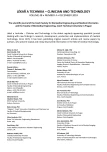Nanofiber scent carrier
Autoři:
Radek Divín; Bruno Sopko; Jiří Ščučka; Evžen Amler
Vyšlo v časopise:
Lékař a technika - Clinician and Technology No. 4, 2018, 48, 123-130
Kategorie:
Original research
Souhrn
The nanofiber scent carriers prepared by electrospinning from poly-vinyl-butyral (PVB), poly-ε-polycaprolactone (PCL), poly-vinyl - alcohol (PVA) and nylon 6/6 were tested as materials for collecting and preserving cigarette tobacco olfactory trace. Nanofiber material can include polar groups on its surface that influence wettability and also attracting of specific molecules creating olfactory trace. Nanofiber material and Aratex were also morphologicaly compared by scanning electron microscope (SEM) where nanofiber carrier had from twenty-two times to thirty-six times smaller fibre diameter than Aratex fibres. Olfactory testing of nanofiber scent carriers were compared to Aratex as traditionally used material for collecting of olfactory traces in criminology. Olfactory tests were carried out by dogs with special training and by mass spectrometer. Olfactory tests carried out by dogs clearly proved that nanofiber scent carriers were able to collect and preserve olfactory trace of lower concentration despite of their lower weight compared to samples of Aratex material. Olfactory tests carried out by mass spectrometer affirmed better olfactory properties of nanofiber scent carriers compared to Aratex, when nanofiber scent carriers were able to preserve 9 of 14 specific molecules characteristic for cigarette tobacco compared to Aratex that was able to preserve only 5 of 14 specific molecules characteristic for cigarette tobacco. The experiments with olfactory trace detection with materials with a comparable mass are in progress.
Zdroje
- Buck L, Axel R. A novel multigene family can encode odorant receptors: A molecular basis for odor recognition. Cell 1991 Apr 5;65 : 175–187.
- Keller A, Vosshall LB. Human olfactory psychophysics. Curr Biol 2004 Oct 26;14 : 875–8.
- Mombaerts P. Genes and ligands for odorant, vomeronasal and taste receptors. Nat Rev Neurosci 2004 Apr 1;5 : 263–78.
- Niimura Y, Nei M. Evolution of olfactory receptor genes in the human genome. Proc Natl Acad Sci 2003 Oct 14;100 : 12235–40.
- Buck LB. Olfactory receptors and odor coding in mammals. Nutr Rev 2004 Nov;62 : 184–8.
- Brookes JC, Hartoutsiou F, Horsfield AP, Stoneham AM. Could humans recognize odor by phonon assisted tunneling? Phys Rev Lett 2007 Jan 19;98 : 038101.
- Franco MI, Turin L, Mershin A, Skoulakis EM. Molecular vibration-sensing component in Drosophila melanogaster olfaction. Proc Natl Acad Sci 2011 Feb 14;108 : 3797–802.
- Komarov IM, Markhgeim V, Novikova AE, Tonkov EE. Micro-biological Method for Forensic Identification of a Man: Problem Setting, Res.J.Med.Sci 2015;9(4):214–217.
- Ma W, Liu X and Pawliszyn J. Analysis of human breath with micro extraction techniques and continuous monitoring of carbon dioxide concentration. Analytical and Bioanalytical Chemistry 2006 Jul 18;385 : 1398–1408.
- Amann A, Smith D. Breath Analysis for Clinical Diagnosis and Therapeutic Monitoring. World Scientific: Singapore, 2005 May.
- Spinhirne JP, Koziel JA and Chirase NK. A device for non-invasive on-site sampling of cattle breath with solid-phase microextraction. Biosystems Engineering 2003 Feb;84(2):239–246.
- Phillips M, Herrera J, Krishnan S, Zain M, Greenberg J and Cataneo RN. Variation in volatile organic compounds in the breath of normal humans. Journal of Chromatography B 1999 Jun 11;729(1–2):75–88.
- Phillips M, Glesson K, Hughes JMB, Greenberg J, Cataneo RN, Baker L and McVay WP. Volatile organic compounds in breath as markers of lung cancer: a cross-sectional study. Lancet 1999 Jun 5;353 : 1930–1933.
- Prado C, Marín P and Periago JF. Application of solid-phase microextraction and gas chromatography–mass spectrometry to the determination of volatile organic compounds in end-exhaled breath samples. Journal of Chromatography A 2003 Sept 5;1011:
125–134. - Jezierski T, Ensminger J, Papet L, CanineOlfaction Science and Law. Boca Raton: CRC Press 2016.
- Ondarcuhu T, Joachim C. Drawing a single nanofiber over hundreds of microns. Europhys Lett 1998 Apr 15;42(2):215–20.
- Feng L, Li S, Li H, Zhai J, Song Y, Jiang L, et al. Super-Hydrophobic Surface of Aligned Polyacrylonitrile Nanofibers. Angew Chem Int Ed 2002 Mar 27;41(7):1221–3.
- Martin CR. Membrane-based synthesis of nanomaterials. Chem Mater 1996 Aug 14;8 : 1739–46.
- Ma PX, Zhang R. Synthetic nano-scale fibrous extracellular matrix. J Biomed Mat Res 1999 June 26;46 : 60–72.
- Liu GJ, Ding JF, Qiao LJ, Guo A, Dymov BP, Gleeson JT, et al. Polystyrene-block-poly (2-cinnamoylethyl methacrylate) nano-fibers-Preparation, characterization, and liquid crystalline properties. Chem-A European J 1999 Aug 30;5 : 2740–9.
- Deitzel JM, Kleinmeyer J, Hirvonen JK, BeckTNC. Controlled deposition of electrospun poly(ethylene oxide) fibers. Polymer 2001 May 7;42 : 8163–70.
- Wang D, Sun G, Xiang B, Chiou BS. Controllable biotinylated poly(ethylene-co-glycidyl methacrylate) (PE-co-GMA) nano-fibers to bind streptavidin–horseradish peroxidase (HRP) for potential biosensor applications,European Polymer Journal, 2008 May 7;44 : 72032–2039.
Štítky
BiomedicínaČlánok vyšiel v časopise
Lékař a technika

2018 Číslo 4
Najčítanejšie v tomto čísle
- GLOBAL CENTERS OF MEDICAL DEVICE TECHNOLOGY: UNITED STATES, EUROPE AND CHINA
- Computer-aided modeling and additive manufacturing fabrication of patient-specific mandibular implant
- Nanofiber scent carrier
- Immediate effect of physical on blood flow velocity in radial artery in young adults
